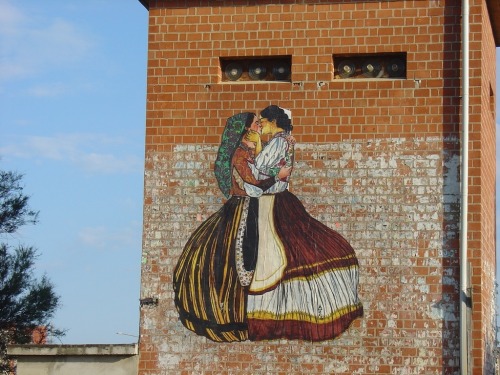A-walk-amongst-faeries - A Happy Place

More Posts from A-walk-amongst-faeries and Others

The Moon
Artist: Alphonse Mucha
Date: 1902
heres a TOTALLY BLANK image!! there is DEFINITELY NO REASON for u to click it!!!!!!!!! NOT AT ALL!!!!!!!!!!!



lesbian street art, Sardinia
![[The Mermaid And The Red Candles], Mesmerizing Figurine Designed By @sheepeden And Sculpted By @tsukachuma](https://64.media.tumblr.com/88bbf0ad7e61a528c81f1616bf99b4a4/tumblr_ptlusxskBg1tplsbvo3_500.jpg)
![[The Mermaid And The Red Candles], Mesmerizing Figurine Designed By @sheepeden And Sculpted By @tsukachuma](https://64.media.tumblr.com/b9e19c7a845703cdbc2a0b0153ddf961/tumblr_ptlusxskBg1tplsbvo2_500.jpg)
![[The Mermaid And The Red Candles], Mesmerizing Figurine Designed By @sheepeden And Sculpted By @tsukachuma](https://64.media.tumblr.com/172143a51b5df7d90db7bf26e5c33e3a/tumblr_ptlusxskBg1tplsbvo1_500.jpg)
![[The Mermaid And The Red Candles], Mesmerizing Figurine Designed By @sheepeden And Sculpted By @tsukachuma](https://64.media.tumblr.com/144663465bca5dddf8cb611d201360bd/tumblr_ptlusxskBg1tplsbvo5_500.jpg)
![[The Mermaid And The Red Candles], Mesmerizing Figurine Designed By @sheepeden And Sculpted By @tsukachuma](https://64.media.tumblr.com/5fc20316614f96f9af3ae0a74aca0137/tumblr_ptlusxskBg1tplsbvo4_500.jpg)
[The mermaid and the red candles], mesmerizing figurine designed by @sheepeden and sculpted by @tsukachuma
It is inspired by a tale written by the “Japanese Andersen”, Mimei Ogawa:
Once upon a time, a beautiful mermaid lived off the shores of Japan. Throughout the mermaid’s life, she had been told how different humans were from mermaids. Particularly, that the humans were always warm and loving. When the mermaid gave birth, she wanted the most for her daughter and left the new born at a shrine on land. (continue reading - transcription on @lets-talk-story)



I want to live on bumblebee blvd. 🐝

i’ve spent countless hours sitting in front of this beautiful view
Me: :(
Old buildings with ivy creeping gently up their sides: ...
Me: :)

http://almightynature.tumblr.com/

Nocturne in Black and Gold - The Falling Rocket
This particular painting within Whistler’s nocturne series spurred the debate on the role of art and critic within modern art. Whistler portrays fireworks over the river, substituting narrative for atmosphere, creating a dark whimsical mood through a restricted palette. The artwork itself is a prime ‘art for art’s sake’ example, as it doesn’t contain a clear narrative on the surface. The work became the epitome of the Aesthetic movement, one that focused on the visual stimulation of art rather than a narrative. The idea is that the painting is independent from any social or political themes. Of course, this idea rejected any traditional values established in the fine art society of the time.
The Falling Rocket became very controversial when it was revealed to the public, even more so when famous critic John Ruskin (1819-1900) released his opinion on it in his published letters, Fors Clavigera, in 1877. This review was incredibly negative. Ruskin criticized the painting on its limited effort, its role in capitalist art, and stated that it was only “flinging a pot of paint in the public’s face.” This resulted in Whistler suing Ruskin for libel.
The Ruskin vs Whistler trial lasted for only two days, yet represented something much bigger than the feelings of a critic and an artist. The trial itself was quite the disaster for Whistler, as at one point the painting was brought out and presented upside-down. However, Whistler won the case, yet both men were hit hard. Regardless of his win, Whistler was awarded just one farthing in damages, and the cost of the court case plunged him even further into debt. Ruskin’s reputation as a critic and trusted voice within Victorian society was damaged.
Nocturne in Black and Gold - The Falling Rocket, 1875, by James Abbott McNeill Whistler (1834-1903)
-
 rajavomwaldrand liked this · 3 months ago
rajavomwaldrand liked this · 3 months ago -
 delusionsof-grandeur reblogged this · 8 months ago
delusionsof-grandeur reblogged this · 8 months ago -
 acciobooksandsunshine reblogged this · 8 months ago
acciobooksandsunshine reblogged this · 8 months ago -
 nemophillisty reblogged this · 11 months ago
nemophillisty reblogged this · 11 months ago -
 phenomenom liked this · 11 months ago
phenomenom liked this · 11 months ago -
 murakamijeva-muza liked this · 11 months ago
murakamijeva-muza liked this · 11 months ago -
 murakamijeva-muza reblogged this · 11 months ago
murakamijeva-muza reblogged this · 11 months ago -
 89rooms reblogged this · 11 months ago
89rooms reblogged this · 11 months ago -
 truckdrivershowcase liked this · 1 year ago
truckdrivershowcase liked this · 1 year ago -
 dandelioninajungle reblogged this · 1 year ago
dandelioninajungle reblogged this · 1 year ago -
 fearless-life-explorer liked this · 1 year ago
fearless-life-explorer liked this · 1 year ago -
 drowning-in-depravity reblogged this · 1 year ago
drowning-in-depravity reblogged this · 1 year ago -
 shaneweavr liked this · 1 year ago
shaneweavr liked this · 1 year ago -
 feisty-n-spicy liked this · 1 year ago
feisty-n-spicy liked this · 1 year ago -
 conmepenonbuzz liked this · 1 year ago
conmepenonbuzz liked this · 1 year ago -
 miss-miaumiau reblogged this · 1 year ago
miss-miaumiau reblogged this · 1 year ago -
 xaeraia liked this · 1 year ago
xaeraia liked this · 1 year ago -
 rosethornblood liked this · 1 year ago
rosethornblood liked this · 1 year ago -
 wixed liked this · 2 years ago
wixed liked this · 2 years ago -
 leprousarmadillo reblogged this · 2 years ago
leprousarmadillo reblogged this · 2 years ago -
 leprousarmadillo liked this · 2 years ago
leprousarmadillo liked this · 2 years ago -
 smrtsmrt reblogged this · 2 years ago
smrtsmrt reblogged this · 2 years ago -
 jessimoonheart reblogged this · 2 years ago
jessimoonheart reblogged this · 2 years ago -
 jessimoonheart liked this · 2 years ago
jessimoonheart liked this · 2 years ago -
 weareautumncourt reblogged this · 2 years ago
weareautumncourt reblogged this · 2 years ago -
 darkvictories-fullheart reblogged this · 2 years ago
darkvictories-fullheart reblogged this · 2 years ago -
 a-wee-batty-batbrat reblogged this · 2 years ago
a-wee-batty-batbrat reblogged this · 2 years ago -
 elegiacescapist liked this · 2 years ago
elegiacescapist liked this · 2 years ago -
 weareautumncourt reblogged this · 2 years ago
weareautumncourt reblogged this · 2 years ago -
 corvusmellorii reblogged this · 2 years ago
corvusmellorii reblogged this · 2 years ago -
 corvusmellorii liked this · 2 years ago
corvusmellorii liked this · 2 years ago -
 talvikkis-paradise reblogged this · 2 years ago
talvikkis-paradise reblogged this · 2 years ago -
 talvikkis-paradise liked this · 2 years ago
talvikkis-paradise liked this · 2 years ago -
 aliceabsinthe reblogged this · 2 years ago
aliceabsinthe reblogged this · 2 years ago -
 aliceabsinthe liked this · 2 years ago
aliceabsinthe liked this · 2 years ago -
 rosiekay reblogged this · 2 years ago
rosiekay reblogged this · 2 years ago -
 pierangelis reblogged this · 2 years ago
pierangelis reblogged this · 2 years ago -
 pierangelis liked this · 2 years ago
pierangelis liked this · 2 years ago -
 postcardsfromliminalplaces liked this · 2 years ago
postcardsfromliminalplaces liked this · 2 years ago
